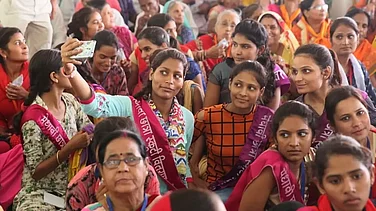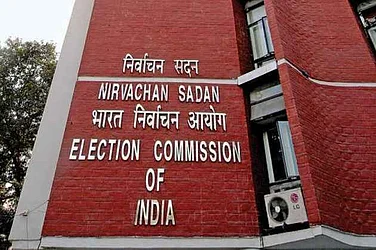In April 2017, a network of Rashtriya Swayamsevak Sangh (RSS)-affiliated organisations exhibited an unprecedented strength across West Bengal on the occasion of Ram Navami, a hitherto-marginal festival in the state, with ‘DJ songs’ in Hindi playing out aloud in tableaus, accompanied by Hindi slogans praising Lord Ram by saffron-headband-wearing and flag- and sword-waving participants. Chief minister Mamata Banerjee dubbed the saffron camp’s display as an imposition of ‘alien’ north-Indian culture on Bengal’s soil and also announced that henceforth Bengali will be mandatory in every school, either as first, second or third language. “Students are free to choose two other languages of their preference but Bengali has to be one of the three,” she first said in mid-April, and then repeated the stance through May.
Her language move was widely seen as her attempt to play with Bengali ethnic sentiments to counter attempted polarisation on religious lines. Cultural dominance is among the worst fears for a Bengali, a community proud of its sense of cultural excellence or superiority. Bengalis have laid down lives—three students in Dhaka in 1952 while protesting imposition of Urdu, 11 in Assam’s Silchar in 1961 while protesting imposition of Assamese on Bengali-majority Barak Valley, and in 1970-71, Bangladesh was born through a bloody war to thwart West Pakistan’s attempt to impose Urdu on the Bengali-speaking people of the East.
ALSO READ: Let A Language Contend
In the Darjeeling hills, Bimal Gurung, the undisputed head of the Gorkha Janmukti Morcha (GJM) that was spearheading a movement for a separate Gorkhaland state through bifurcation of Bengal, was long waiting for a ‘loose delivery’ from the chief minister, who had started gaining grounds in the hills with a slew of new development works. Gurung, after preparing his own ground through May, called for widespread protests against ‘Bengali imperialism’ during Banerjee’s visit to Darjeeling in early June.
The fire that broke out in Darjeeling during her visit over Gurung’s followers’ violent protests claimed the lives of 11 GJM supporters and one sub-inspector of police, apart from causing massive destruction of government and private properties and a bandh of the hills that stretched over 105 days. By the time the government clarified that the decision did not apply to areas dominated by people who have Nepali, Santhali and Rajbanshi as their mother tongue, it was too late.
Linguistic identity, or the lack of it, has been one of the drivers of the Gorkhaland demand. In a country where state borders have mostly been determined by language, the Gorkhas of Darjeeling have no state of their own. They speak Nepali, also called Gorkhali, the main language of neighbouring Nepal. Of India’s 29.26 lakh Nepali-speaking people (Census 2011), 11.5 lakh, or 39.4 per cent, live in West Bengal, concentrated mostly in the Darjeeling hills. But a much larger Nepali-speaking population lives beyond the international border—1.18 crore in Nepal.
“People in other parts of India disparaging Nepali-speaking Indians as foreigners has been a common experience for most of us,” says Lekhnath Chhetri, author of the Nepali-langauge fiction, Phulange. “That’s why the Gorkhaland movement is also about the sentiment of having a homeland for the Nepali-speaking people of India. The statehood movement of the 1980s had taken a lot of steam from the language movement that happened earlier.” Even though Nepali is Sikkim’s most-spoken language, Sikkim’s own language, Sikkimese or Bhutiya, has its ancestry in Tibetan. Gorkhas, therefore, do not consider Sikkim their homeland in India.
Call it ironic, speakers of Bengali language have suffered similar identity crises in other parts of India despite having a homeland of their own. Bengali is the second-most spoken language in the Indian subcontinent, and the world’s seventh-most spoken. In 2011, an estimated 14.5 crore speakers lived in Bangladesh, while 7.87 crore lived in West Bengal and another 1.85 crore spread across other parts of India. The recent incident of Delhi’s ruling Aam Aadmi Party (AAP) leadership branding Jahangirpuri’s Bengali-speaking Muslim population as Bangladeshis is a latest addition to the list, following which rallies came out in Calcutta on April 22 protesting the branding of all Bengalis as Bangladeshis.

If such incidents over ‘Bangladeshis’ have risen in scale in northern, western or southern India over the past few years—perhaps triggered by the National Register of Citizens (NRC) and Citizenship Amendment Act (CAA) controversy—in India’s Northeast, Bengali-speaking people have lived with the tag of Bangladeshi for over six decades. A 2020 incident, of posters coming up in different parts of Meghalaya, courtesy the Khasi Students’ Union, declaring “All Meghalaya Bengalis are Bangladeshis”, was the latest addition to a long list. Going by demographic data of 2011, out of India’s 9.72 crore Bengali-speaking population, at an estimated 7.87 crore lived in West Bengal, and another 1.2 crore were spread over northeastern states—90 lakh in Assam, 24 lakh in Tripura, 2.32 lakh in Meghalaya, 1 lakh each in Mizoram and Arunachal Pradesh, 76,000 in Nagaland and 30,000 in Manipur.
In the context of the Northeast, Bangladesh becomes an important point, not only because of the post-Partition migration of Hindu refugees, but also due to the pre-Partition migration. According to 2011 Census data, with a total population of 4.5 crore speaking many languages across the ‘seven sisters of the east’, the northeastern states together had a population of 1.2 crore Bengalis amidst them, and another 22 crore on its western and southwestern borders—with 14.5 crore in Bangladesh. Bengali is the second-most spoken language in the Northeast, after Assamese (1.52 crore). However, in the rest of the six states of the region, only 1.16 lakh people spoke Assamese, while these states had nearly 30 lakh Bengali-speakers.
“The Northeast has a love-hate relationship with Bengal and Bengalis. There is animosity, because they remember the Bengali dominance of the past. They fear being overrun by Bengalis,” says Samrat Choudhury, co-editor of a volume called Insider Outsider: Belonging and Unbelonging in North-east India. He adds, “Bengalis of post-Independence India who migrated to the region as Partition refugees had to pay for it. They have largely been forced out. There has been a sustained exodus over many years.”
In 1717, Santidas Adhikary (or Gosain), a Bengali Vaishnavite preacher from Sylhet district who had gone to Manipur, converted king Pamheiba into Hinduism. The king subsequently made Bengali the official language and in 1729, burnt down all ancient Manipuri script written in Meiteilon script. Since then, Manipuri has been written in Bengali script and till date the Bengali script is used in publications and newspapers, even though school instructions have started in their original script. Meanwhile, in 2005 there was the shocking incident of burning down the state central library because most of the books it had were in the Bengali script.
In modern Assam, Meghalaya and Mizoram, such imposition of Bengali happened after it became part of British Bengal. Besides, there was the role of the Danish Christian missionaries of the Serampore mission. After having printed books on Bengali grammar and translations of the Bible in Serampore near Calcutta, they focussed on the Northeast. However, their Bible in Assamese, published in 1819, was borrowed largely from Bengali. In 1839, in the Khasi hills, where the eponymous language had no script, they printed the Bible in Khasi language but in Bengali script.
According to Choudhury, Bengali Brahmins had already settled in many parts of the Northeast, such as the Manipur valley, Tripura and the plains of Sylhet (in modern-day Bangladesh) which were ruled by Jaintia kings during the 16th and 17th centuries. However, the linguistic conflict in Northeastern India started with the standardisation of languages that accompanied the arrival of the first printing press with American Baptist Christian missionaries in the 19th century following the British annexation of Assam, a process that started in 1826. “The British authorities initially made Assam a part of the Bengal Presidency, treated Assamese as a dialect of Bengali, and made Bengali the medium of instruction in the schools they opened. This is remembered with anger and fear by many Assamese to this day,” Choudhury says.
The missionaries led by Nathan Brown and Miles Bronson translated the New Testament into what they considered standard Assamese, meaning the dialect of Upper Assam, and published the first Assamese grammar in 1848. “They took up the cause of the Assamese language,” Choudhury tells Outlook. The conflict between the two linguistic identities took on a new force after the administrative separation of Assam from Bengal province in 1874. With competition over education and jobs between the elites and emerging middle classes of both linguistic communities increasing, and the divide continued to deepen.
The census of 1881 shows the Assam commissionerate had a Bengali-speaking population of 24.25 lakh, whereas only 13.61 lakh spoke Assamese. The province, however, included the Bengali-speaking districts of Sylhet (in today’s Bangladesh), Cachar and Goalpara (in present-day Assam), apart from the Naga hills, Garo hills, Khasi hills, Jaintia hills and Lushai hills—mostly the areas forming the modern-day states of Meghalaya, Mizoram and Nagaland. As Shillong was made the headquarters of the new chief commissioner’s province of Assam, the town emerged as a ‘Bengali island’ amid tribals of the Garo, Khasi and Jaintia hills, as Bengalis, mostly from Sylhet, grabbed most of the administrative job opportunities.
The 1891 Census report makes an interesting comment, “Assamese…like Oriya, has had the experience of resisting the attempt of the ambitious Bengali to reduce it to a patois, and thus open a wider field of employment to the studious youth of the lower provinces; and like Oriya, too, Assamese has been hitherto successful.” The Assamese had to take up such a battle with Bengali ‘dominance’ even a century later—in the 21st century they had to fight with authorities of Unicode, an international encoding standard for use with different languages and scripts, which listed Assamese as a dialect of Bengali. For all practical purposes, this meant Assamese content would not appear on internet searches. They have won this battle partly, as the International Standards Organisation (ISO), after much persuasion, agreed in 2018 to change the listing as Bengali-Assamese instead of Bengali.
(This appeared in the print edition as "United by Geography, Divided by Language")
ALSO READ


























